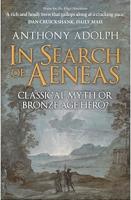
Amberley (2023) h/b 352pp £25 (ISBN 9781398105362)
A. is a professional genealogist, broadcaster and author and he is clearly committed to thorough research. A. has already written a biography of Aeneas’ mythological great-grandson, Brutus of Troy, so this world is not new to him. He has now spent ten years travelling with a companion across Europe and Asia and visiting every site where any reference to or connection with Aeneas, or a character of a similar name and lineage, has been found or claimed over past millennia. He also read a vast number of sources: ancient works in translation and more modern works, studying operas, films and TV series, as well as novels. Some of his sources, such as Dares of Phrygia’s History of the Fall of Troy, which purports to be a first-hand account of the Trojan War by Dares, a Trojan priest of Hephaestus in the Iliad, but was probably written in Rome in the early 6th C AD, may well be unfamiliar. The book is divided into two parts: Troy and Rome. It includes an introduction, sketch maps, colour photographs of various sites and paintings, Aeneas’ family tree, a family tree connecting Aeneas to the rulers of Rome, a timeline, end notes, bibliography and index.
The first chapter of the first part focuses on various re-imaginings of Aphrodite’s seduction of Anchises, with Aeneas as the resulting offspring, and the baby’s early upbringing by the nymphs: ‘…when the man fated to become Aeneas’ father saw an inexplicably pure radiance, emanating from the breasts of the girl who stood before him on Mount Ida, inflaming him with desire and making him wonder if she might be a goddess…”. A similar legend on Samothrace is also investigated by A. in person and magnetic rock discovered. Moving forwards, Aeneas’ key role in the ‘abduction’ of Helen of Sparta, leaving Paris to take a back seat in the venture, is explored in significant depth. The emphasis then shifts to a very detailed and lengthy examination of the events of the Trojan War and the Greeks’ final victory.
In the second part, A. follows Aeneas’ long and arduous journey to Italy, with much reference to Virgil’s Aeneid. He explains that it was the Julian clan, starting with Julius Caesar, who had developed an interest in Aeneas as a Roman hero and who sought to claim descent from Aeneas to enhance their own lineage. A. cites Ursula Le Guin’s novel, Lavinia, as his main source for the details of their love and marriage and notes Livy’s claim that Lavinia ruled as regent in Lavinium after Aeneas’ death, until his son, usually known as Silvius, came of age. Somehow, his descendants were later linked to the traditional founders of Rome.
This book is not for the faint-hearted. It is a long and very complex tome which roams far and wide and leaves no stone unturned, no reference, however tentative, unexplored. It is aimed at the general reader who has an interest in the classical world and in Aeneas in particular. A.’s research is nothing if not extensive, but many of his ideas, propositions and, sometimes tentative, conclusions will seem implausible to classical scholars.
Marion Gibbs
